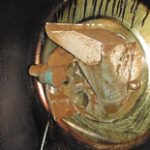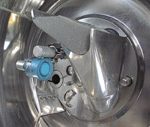The possibility of fully-automatic cleaning in place with verified cleaning efficiency (cleaning validation) is a prerequisite in every process stage of modern pharmaceutical plants. The process zone is not inspected and analysed until the cleaning step has been completed. CIP and inspection usually require special design and process-related features.
The HZ-Ph peeler centrifuge series is designed to meet these special requirements. The following design features are beneficial to the CIP cleaning process in this centrifuge:
• The fully-opening hinged door permits fast and thorough inspection of all surfaces that come into contact with the product.
• All positions on the housing jacket slope towards the drain nozzle, thus practically ruling out any formation of puddles.
• The heel of the filter cake – formerly inevitable in peeler centrifuges – is removed automatically.
• Several strategically positioned cleaning nozzles manage to reach surfaces which could otherwise cause problems.
• Open O-rings eliminate the previously common dead spaces in the sealing area.
• Large radii instead of sharp edges and corners hinder product deposits.
• The housing can be flooded („washing machine effect“).
• Strict separation of the process area and drive part of the centrifuge.
Efficiency verification
Extensive CIP cleaning tests have led to remarkable results. A Belgian pharmaceutical manufacturer provided several product samples for testing purposes, to enable a comparison with the relatively old peeler centri-fuges presently installed.
With one of these products, the centrifuge used today has to be cleaned in a highly complex process with high-pressure spray equipment and with the housing open. The cleaning process lasts several hours. The tests using the same product on the HZ 630 Ph test centrifuge were most convincing. Figure 1 shows the soiled process area after one complete batch operation of the centrifuge (including heel removal) and prior to commencement of the CIP cleaning process. The tar-like product deposits are clearly indicated by the brown colouring.
The cleaning process
In order to minimise solvent consumption, only water was used here for pre-cleaning. The cleaning process started with a preliminary flush with hot water via all the cleaning nozzles at reduced speed. The maximum water consumption was 100 l at an inlet pressure of 5 bar. At the end of this stage a product residue remained on the filter cloth and on surfaces that were difficult to access. Then – after the closing all the discharge pipes on the centrifuge – the housing was flooded with approximately 100 l of hot water at reduced speed for a period of about 10 minutes. At the end of this cleaning stage the entire process area and the filter cloth were clean, based on a visual inspection. Merely foam deposits remained. Finally, all detectable soiling or foam residues were removed by post-flushing with approximately 80 l of water via all the cleaning nozzles.
The finishing touch was added by flooding the centrifuge again with acetone. The product dissolves in acetone. The housing was then filled with up to 70 l. The basket speed and the scraper position were varied according to a fixed pattern for a period of approximately 15 minutes. After draining the fluid, there was no longer any sign of the batch which had just been processed in the centrifuge (Fig. 2).
Convincing results
In comparison to the production centrifuges installed today, the duration of the cleaning process (approximately five hours with a manual method and the housing open) is reduced to less than one hour with the machine closed and fully automatic operation. At the same time, there is also a considerable reduction in the quantity of cleaning fluid used.
An analysis was carried out of the cleaning results of similar tests with different products from a German pharmaceuticals manufacturer. The cleaning result was below the permissible limit for all products – in some cases it was even below the detection level.
As far as maximising product quality and minimising the hazards for the operating personnel are concerned, this plant operator with the HZ-Ph peeler centrifuge has made a very good choice. The centrifuge is particularly suitable for multiple product plants or for applications where clean equipment is vital.
Krauss-Maffei
Fax: ++49/89/88 99 32 99
Further information cpp-200
Unsere Webinar-Empfehlung
Die Websession „Wasserstoff in der Chemie – Anlagen, Komponenten, Dienstleistungen“ (hier als Webcast abrufbar) zeigt technische Lösungen auf, die die Herstellung und Handhabung von Wasserstoff in der chemischen Industrie sicher machen und wirtschaftlich gestalten.
Ob effizienter…
Teilen:












